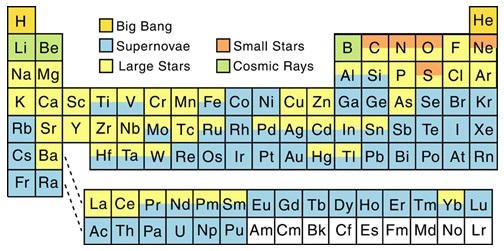The recently refurbished Hubble Space Telescope has taken a new look at Supernova 1987A and its famous “String of Pearls,” a glowing ring 6 trillion miles in diameter encircling the supernova remnant. The sharper and clearer images are allowing astronomers to see the “innards” of the star being ejected into space following the explosion, and comparing the new images with ones taken previously provides a unique glimpse of a young supernova remnant as it evolves. They found significant brightening of the object over time, and also evident is how the shock wave from the star’s explosion has expanded and rebounded.
Kevin France from the University of Colorado Boulder and colleagues compared the new Hubble data on the SN1987A taken in 2010 with older images, and observed the supernova in optical, ultraviolet and near-infrared light. They were able to look at the interplay between the stellar explosion and the ‘String of Pearls’ that encircles the supernova remnant. The gas ring — energized by X-rays — likely was spewed out about 20,000 years before the supernova exploded, and shock waves rushing out from the remnant have been brightening some 30 to 40 pearl-like “hot spots” in the ring — objects that likely will grow and merge together in the coming years to form a continuous, glowing circle.
[/caption]
“The new observations allow us to accurately measure the velocity and composition of the ejected ‘star guts,’ which tell us about the deposition of energy and heavy elements into the host galaxy,” said France, lead author of the study which was published in Science. “The new observations not only tell us what elements are being recycled into the Large Magellanic Cloud, but how it changes its environment on human time scales.”
The significant brightening that was detected is consistent with some theoretical predictions about how supernovae interact with the galactic environment surrounding them. Discovered in 1987, Supernova 1987A is the closest exploding star to Earth to be detected since 1604 and is located in the nearby Large Magellanic Cloud, a dwarf galaxy adjacent to our own Milky Way Galaxy.
In addition to ejecting massive amounts of hydrogen, 1987A has spewed helium, oxygen, nitrogen and rarer heavy elements like sulfur, silicon and iron. Supernovae are responsible for a large fraction of biologically important elements, including oxygen, carbon and iron found in plants and animals on Earth today, France said. The iron in a person’s blood, for example, is believed to have been made by supernovae explosions.
The team compared STIS observations in January 2010 with Hubble observations made over the past 15 years on 1987A’s evolution. STIS has provided the team with detailed images of the exploding star, as well as spectrographic data — essentially wavelengths of light broken down into colors like a prism that produce unique fingerprints of gaseous matter. The results revealed temperatures, chemical composition, density and motion of 1987A and its surrounding environment, said France.
Since the supernova is roughly 163,000 light-years away, the explosion occurred in roughly 161,000 B.C., said France. One light year is about 6 trillion miles.
“To see a supernova go off in our backyard and to watch its evolution and interactions with the environment in human time scales is unprecedented,” he said. “The massive stars that produce explosions like Supernova 1987A are like rock stars — they live fast, flashy lives and die young.”
France said the energy input from supernovae regulates the physical state and the long-term evolution of galaxies like the Milky Way. Many astronomers believe a supernova explosion near our forming sun some 4 to 5 billion years ago is responsible for a significant fraction of radioactive elements in our solar system today, he said.
“In the big picture, we are seeing the effect a supernova can have in the surrounding galaxy, including how the energy deposited by these stellar explosions changes the dynamics and chemistry of the environment,” said France. “We can use this new data to understand how supernova processes regulate the evolution of galaxies.”
France and his team will be looking at Supernova 1987A again with Hubble’s Cosmic Origins Spectrograph, an instrument which scientists hope will help them better understand the “cosmic web” of of material permeating the cosmos and learn more about the conditions and evolution of the early universe.
Source: ScienceExpress







